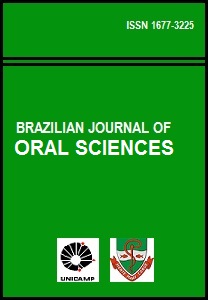Abstract
Aim: The goals of this study were: 1) to estimate the prevalence of oral candidiasis (OC) in a sample of Brazilian HIV-infected adult patients, and 2) to investigate the risk factors for HIVassociated OC in this sample. Methods: This case-control study included 112 HIV-infected patients treated between 2002 and 2004 at a clinic for sexually transmitted diseases. Data were collected from medical records and clinical examinations. Diagnosis of OC was performed in accordance with the International Classification System and cytological features. Seventeen clinical and laboratorial variables were registered. Univariate analyses were performed on all variables. Multiple logistic regression techniques were used to develop a model and identify the set of variables that may predict risk factors in HIV-infected adult patients with OC. Results: Prevalence of OC was 31.3%. OC was associated with oral hairy leukoplakia (OHL) [p<0.001; odds ratio (OR) = 10.2 (95%CI: 4.0-26.0)], previous use of fluconazole [p<0.001; OR=27.4 (95%CI: 8.1-92.0)] and viral load [p=0.042; OR=2.3 (95%CI: 1.0-5.3)]. Conclusions: These results are important for the development of strategies to eliminate these risk factors and significantly reduce OC in HIV-infected patients.The Brazilian Journal of Oral Sciences uses the Creative Commons license (CC), thus preserving the integrity of the articles in an open access environment.
Downloads
Download data is not yet available.

